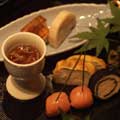|
 |
Take Your Time With Kaiseki THE kaiseki meal is more than just food on a plate. You can't rush through it. Chef Toshio Sawai, 40, of Suntory Japanese restaurant at the Hotel Inter-Continental, feels that many Singaporeans have no time for a kaiseki meal, which can take up to three hours. The most time that any Suntory customer has devoted to a kaiseki meal is a mere hour and a half. 'They are always rushing for the food. They want the food fast and are in a hurry to meet the next appointment. I cannot see many Singaporeans devoting three whole hours to a kaiseki meal,' said chef Sawai. A kaiseki meal is distinguished by delicately arranged food served at carefully timed intervals. The time between servings must be enough to create two moods: The anticipation of the dish and the satisfaction derived from it. To understand why a proper kaiseki meal can take up to three hours, one must look into its history and meaning. The word comes from a tradition followed by Buddhist priests in strict Zen training. They kept a hot stone (seki) in their kimono pocket (kai). The stone would warm the stomach and make the fasting more bearable. Kaiseki-ryori is also served during traditional tea ceremonies - cha kaiseki. The light meal served during the ceremony is called kaiseki. The restaurant host is important as he has the job of sensing the mood of his patrons. Only then can he determine the necessary intervals between each course. A typical menu is seven courses and sake is served in between each dish. The type of food you get is strictly seasonal. It takes a long time and great effort to prepare the meal as the natural flavours of each ingredient are painstakingly preserved. The plates and cutlery are made from an assortment of materials, ranging from cedar to ceramic and lacquer. They are chosen to enhance the colour, shape and texture of each seasonal food. A kaiseki gourmet can tell which season it is just by looking at the meal. Kaiseki is high in symbolism. For example, each sweet has its own individual name reflecting the seasons. In October, pureed chestnut is moulded into shapes of mountain peaks and valleys with the name 'Mountain Path'. In December, when the first snow blankets the landscape, sweetened azuki and white beans are made into 'Snow on Brushwood'. Another example: The rice is used to symbolise the passage of time. It is slowly cooked throughout the meal such that the customer experiences the changes in texture and flavour. At the end of the meal, the rice is browned and crunchy and served with seasonal pickles. The attention to detail, aesthetics and custom can be costly. In Tokyo, a kaiseki dinner can cost upwards of 25,000 yen (S$208) a person. At the Suntory, however, a kaiseki lunch costs $38+++ and dinner $98+++. So, the next time you venture into a kaiseki restaurant, take a long weekend lunch with your best friend and relax. Sit down, chat, slowly sip sake and deliberately savour the food with open senses and a conscious mind. You may be rewarded with a deeper appreciation and awareness of food that is just not possible if you simply rush through it. |